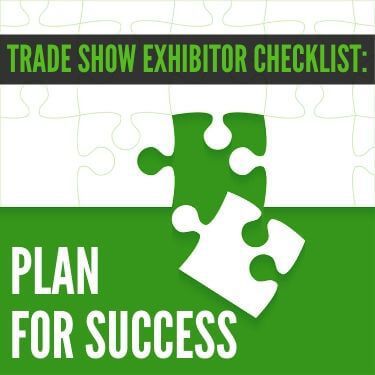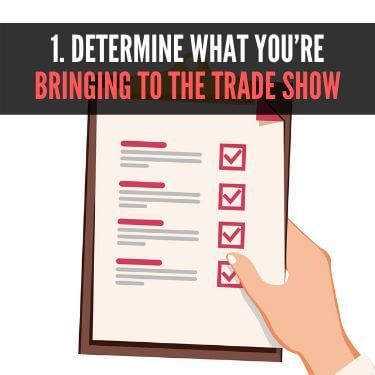
 Copy URL to Clipboard
Copy URL to Clipboard
Planning for a successful trade show can be quite a difficult task, especially if your company has yet to attend one. This could be due to financial constraints or simply because your brand hasn’t been given a chance to be in the limelight. When you do get an opportunity to appear at a trade show, the last thing you want is to make a fool of yourself and give your company a bad reputation. Whether it’s assigning the right booth staff or having a solid social media strategy to get the word out that your business will be attending, we’ve put together this trade show exhibitor checklist that will help you plan ahead for a successful trade show exhibit.
Items on your trade show exhibitor checklist should cover the basics and make sure the show goes on as planned. Your checklist might include:
We’ll be covering seven of the most important components of any successful trade show. From the hardware and general items that you bring to a tradeshow to networking strategies, this article will educate you on the best practices to develop when attending trade shows and also give you some advice on how to measure their impact on your business. This will help you understand the value of trade shows and how they can help your business grow to new heights.
Need help shipping your trade show booth and materials?
Fill out a short form or give us a call and one of our trade show specialists will answer your questions.
Table of Contents

You’ve got one chance to really impress show attendees at a trade show, so it’s important to make a checklist of things that you want to bring to a trade show. There are some basic items such as office supplies which are always handy, such as for writing down notes, but there are also some less-considered items and also the knowledge that you should bring with you to the trade show.
For starters, make sure that the product or service that you want to sell can be taken with you in some shape or form. For instance, you may be required to bring several computer setups and hardware if you’re trying to sell a piece of software, and it’s always a good idea to bring a working prototype or demo unit for physical products. If you’re selling a consumable product, then bringing samples with you is always a fantastic idea. You may also want to consider bringing small gifts for attendees such as branded stationary or something unique such as cupcakes to offer.
You’ll also want to consider bringing a couple of members of your staff depending on the size and scope of your trade show booth. This can depend greatly on the type of product or service that you’re offering. For instance, if there are technical aspects of your product that you don’t quite understand, it’s a good idea to bring engineers and developers that have been working on the project so that they can explain things in more detail to attendees that are interested in specifics.
Once you’ve built a list of things you want to bring to a trade show, you’ll want to start planning the logistics of getting everything to the show itself. For larger or heavier items such as computer setups, samples of your product and prototypes, you’ll want to hire a logistics service to help you ship the items to and from the trade show itself. Depending on the distance, this can be a rather expensive investment but it can be made cheaper and easier when connecting with the right businesses that are designed specifically to help trade show exhibitors.
You’ll also want to coordinate things such as travel. This can be especially important if you have employees that work remotely who are scheduled to attend the trade show itself. This will involve booking travel tickets like flights or trains, and it can also include booking a hotel for the trip so that you have a place to stay. Depending on the event itself, you’ll also likely need to book a booth spot so that you have somewhere to put your things. In some cases, a hotel room can also be used to showcase your items if it’s part of the event. These are all things that need to be taken into consideration.
To help make things easier, we’ve compiled a small but concise checklist of considerations when it comes to coordinating the logistics of a trade show.
Logistics is an important consideration when it comes to planning for a successful trade show, hence why it’s vital to contact a trustworthy and reliable shipping solution. Coordinating something like trade show logistics can take a lot of time and involves a lot of intricate details, hence the importance of hiring a service that is confidence and experience in trade show logistics.
Need help shipping your trade show booth and materials?
Fill out a short form or give us a call and one of our trade show specialists will answer your questions.

Another important component of a successful trade show is budgeting. Whether you’re a relatively small startup or a large corporation, you need to have a budget in mind because, at the end of the day, an appearance at a trade show exhibition is an investment in your brand and measuring its success can help you fine-tune your approach in the future.
There are countless considerations when it comes to budgeting for a trade show, so we’ve put together a brief list of things that you’ll likely be spending money on.
As you can see, budgeting for a trade show involves many different expenses, hence the importance of planning weeks in advance to ensure you have everything covered.
For your trade show booth to be successful it’s important to develop and implement a marketing strategy that focuses on the show. This can involve areas such as social media and reaching out to influencers so that more people know about your attendance at a specific trade show. These considerations are typically split into three sections; pre-show, during the show and post-show.
A pre-show marketing strategy involves a lot of planning around the show itself and the attention it’s getting from the media.
During the show, you’ll want to implement pre-show strategy and planning to use. For example, you’ll want to take a note of all the people you speak to that could be considered leads and trading business cards can help ensure that you can be contacted by the people you’ve spoken to at the show itself.
This is also a good opportunity to continue updating your social media pages with posts regarding your appearance at the show. The show exhibition will likely have an associated hashtag on platforms such as Twitter and Facebook that you can take advantage of to gain more visibility. This is also a good time to network with other businesses and potential clients to help grow your list of contacts.
Need help shipping your trade show booth and materials?
Fill out a short form or give us a call and one of our trade show specialists will answer your questions.
Once the show has concluded, it’s time to follow-up on your leads and the business cards that you’ve traded. This will also be the time when you calculate if your trade show was a success or not based on factors like the number of leads you have, the sales you made or even the people that you’ve networked with. There are countless ways to get value out of a trade show and its success depends on the goals that you originally set out to achieve. If you were able to reach those goals then you can consider the event a great success. Even if you fell short of those goals, you could still continue to get value out of the trade show by following-up with your leads.
You’ll also want to continue using social media to reflect on the event, thank those involved and essentially keep the ball rolling so that your appearance and meetings are still fresh in the minds of those that attended. Recapping the event on your website or blog can also be a great way to keep your audience in the loop and refresh them on what happened during the event. There are endless ways to follow-up after a trade show concludes and it’s vital that you try different things to see what works best for your company.

Discuss the importance of practicing a presentation or sales pitch. If any technology is involved, be sure to test the technology prior to the show.
Before you attend a trade show it’s vital that you understand how to market your product or services to the audience that the show itself. For this, you need two main components; a presentation and a pitch. A presentation is essential for explaining your products or services to a wide audience. It should be comprehensive, concise yet interesting to keep people’s attention. If your presentation doesn’t captivate your audience then it can be difficult to network and build your reputation. For a presentation to be successful, you should also ensure that any technology related to your product (such as computers, hardware or the product itself) is in full working condition. It’s also not a bad idea to have backups in case something breaks or stops working.
You’ll also want to put together a convincing pitch to help you make a good first impression. Whether it’s grabbing someone’s interest once they glance at your booth or even getting someone’s attention in an elevator, having a concise pitch that promotes your product and gets people interested is a great way to spread the word and get more people talking. Make sure you rehearse both your presentation and pitch to ensure that you appear as confident as possible.
Need help shipping your trade show booth and materials?
Fill out a short form or give us a call and one of our trade show specialists will answer your questions.
When you attend a trade show it’s vital that you get as much value out of it as possible. This means that, in addition to showing off your products and services, you should be networking with other vendors and not just potential clients. This is important for a number of different reasons.
Networking is common at trade shows, but in order to truly make the most of your attendance, it’s vital that you network with other vendors in order to gather ideas and potentially form partnerships with other companies that are mutually beneficial.

It’s important to treat your trade show appearance as an investment in your business. After all, you’re probably spending a considerable amount of money on trade show booth materials and it’s not cheap to send a team of staff members to a trade show for a couple of days. As such, it’s vital that you consider how to measure the success of your participation at a trade show. This can vary depending on your initial goals and also the type of product you put on display, but we can boil it down to three different categories.
These are the most common performance metrics to consider when measuring the success of your trade show participation.
Need help shipping your trade show booth and materials?
Fill out a short form or give us a call and one of our trade show specialists will answer your questions.
One of the most difficult things about planning a successful trade show is the logistical side of your trade show exhibitor checklist. It’s perhaps the most involved aspect that, if planned poorly, could result in a disastrous trade show booth that doesn’t serve its purpose. So to help you with trade show planning, it’s important to hire a reputable and confident company that can help you ship all of your materials to the trade show with minimal disruption and issues.
No matter whether you’re shipping to SEMA or shipping to a furniture trade show, R+L Global Logistics can help. R+L Global Logistics is a solution that you can trust. As an experienced and well-equipped global logistics provider for convention shipping, we’re capable of helping you ship your company’s materials to any trade show in the United States or the rest of the world. Contact us today to see how we can become your logistics partner for your next trade show appearance.
Need help shipping your trade show booth and materials? Fill out a short form or give us a call and one of our trade show specialists will answer your questions.
 Copy URL to Clipboard
Copy URL to Clipboard
Need help shipping your trade show booth and materials? Fill out a short form or give us a call and one of our trade show specialists will answer your questions.